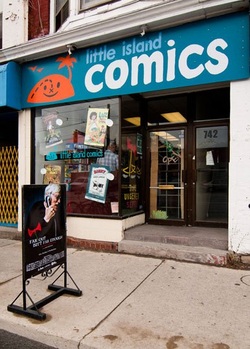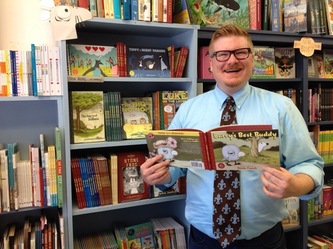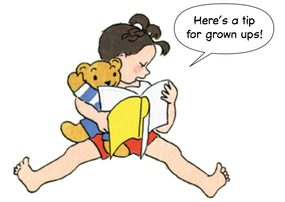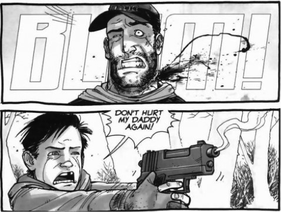We invite you to please read, email, tweet, like, share, and help spread the word about the new TOON Graphics, featured in today's NEW YORK TIMES article, "Comic Books Even Teachers Can Love."
Here's the link: http://nyti.ms/Y0LP1d.
|
WOW! TOON in the Times!? Yes, it's true! We invite you to please read, email, tweet, like, share, and help spread the word about the new TOON Graphics, featured in today's NEW YORK TIMES article, "Comic Books Even Teachers Can Love." Here's the link: http://nyti.ms/Y0LP1d. We are grateful to all of you who have championed our books over the past 6 years. Here's to ALL comics that bring reading enjoyment to kids (and grown ups) everywhere.
0 Comments
How Comics Work (Part 1) By Jay Shapiro Have you ever been trapped in a children’s bookstore with seven or so kids? Well, this happened to me last month and I admit it was pretty refreshing. Not only did it remind me of how smart children are, but I also I ended up with some answers to the complex question of how we perceive stories. Children haven’t yet learned to dance around conversation topics the way adults do, so it was a great set-up. It allowed me to learn a lot and I recommend it.
Shaun Tan’s story, told entirely in pictures–with no words–opens with the protagonist saying goodbye to his family in a vaguely Eastern-European setting, as the shadows of monsters are cast over his homeland. The kids were quick to point out that he was fleeing from a dragon. I said they were probably right, but tried to explain the concept of metaphor. “It doesn’t really need to be a dragon,” I said, “In this case, it’s really just a stand-in for something bad. Let’s say for anything that can get across that idea.”  “The inspection,” from Shaun Tan’s The Arrival “The inspection,” from Shaun Tan’s The Arrival As we went on through the book, the kids offered up their theories on what was actually happening. I told them I loved all of their ideas, but that it might be more useful to look for the emotions the story provokes rather than taking guesses at what each drawing truly represented. “If you focus on the emotions experienced by the reader,” I said, stressing that I wasn’t discouraging them from using their imaginations, “all your theories will be true because the only thing that’s absolutely critical in this story is that the main character feels alienated in his new location.” Reflecting back now, I’m struck by two things that I want to try and explore. The first is the difference between children intuiting and inferring. How do children learn to look at parts of a situation – or in this case, story – interpret it, and infer the information around it, rather than bluntly assuming? To understand this, we first have to examine the most basic principles of a story: Recognizing details, interpreting the meaning of those details, and using that knowledge to infer the information we don’t get. This can be anything as complex as a character going through an emotional revelation brought on by eating a bagel, to something as basic as a character buying a bagel and eating it. Whether we mine away at the hidden details of prose or prick up our senses to the onslaught of information from a movie, understanding a story is dependent on our ability to use the parts to know the sum. It’s no coincidence that we introduce children to reading just as they reach Jean Piaget’s preoperational stage of cognitive development. According to Piaget’s model, between the ages of 2 and 7 children begin to understand the difference between the past and the future, laying the foundation of memory, and develop the ability to associate symbols with inherent meaning. What the model also says is that kids at this stage still lack abstraction and conservation; they usually have trouble grasping ideas beyond physical situations. Going back my Shaun Tan reading, I was going over the story with kids who purportedly were past this stage–indeed they were very much in line with what Piaget calls the concrete-operational phase. They had no problem following the basics of the story, even though at the age of nine or ten, they are much more familiar with full-prose books than with silent comics. But while they accepted my broad abstract statements as interesting, they still clung to the desire to keep the story grounded in concrete facts. When kids are below the age of 7, Piaget points out that they do not infer conclusions from lots of tiny parts, while the kids I was with were clearly past that stage. How does this apply to reading, and more importantly, why is this so critical to comics?  From Understanding Comics by Scott McCloud From Understanding Comics by Scott McCloud In chapter three of Understanding Comics, Scott McCloud elaborates on how comics utilize one mental skill more heavily than any other medium: closure, or “observing the parts, but perceiving the whole.” As McCloud points out, we use closure every day as a mental compensation for the shortcomings of our senses. When you talk on the phone and assume that your friend on the end of the line still has a physical body, you’re using closure. It’s why children in the preoperational phase fantasize that the world goes away when they close their eyes; they base their inferences on intuitive reasoning, not logical reasoning. Reading words is as dependent on closure as any aspect of our lives: once we are able to recognize the full meaning of a sentence, all the sentences together to help simulate a real life experience from only a description of such. But, as McCloud puts it, “Comics is closure.” What exactly does that mean? In one case, it would suggest that comics are made up of closure methods instead of relying upon them. A series of static images is presented and readers must rely upon their knowledge of cause and effect to infer what has happened in between the spaces. Closure in comics is used to fill in the gaps of the story, rather than make the simulation of life more convincing as in written word. It’s startling to me that many parents think that good books for children are gauged by vocabulary size–I now see that the level of abstract representation in a book is what makes it good fodder for a young mind. Knowing all of this, let’s re-evaluate the idea that comics are easier to read than “real books.” When those kids – most of whom already trained to read chapter books – were presented with The Arrival and asked to follow only pictures, and all these pictures can be interpreted both factually and metaphorically, were they not asked to work harder than when reading an ordinary book of prose? I think so. The silent comic, and the visual part of any comics have much more room for interpretation by the reader than a story told in prose. And if it that’s true, maybe comics are one of the best tools we have for teaching inference, for encouraging young readers to go back and forth between literal and metaphoric meaning when they read. In comics, reading is not about following instructions–it’s about creating meaning; comics force you to fill in the gaps in the narrative, just as children learn to fill in the gaps of the world they see. In part 2, I’ll explore the other thing kids do with the knowledge they acquire when reading comics: they imagine their own stories. Jay Shapiro is a native New Yorker studying creative writing at Oberlin College and can be reached via Twitter @JayRayShapiro.
How and where did you discover your first TOON Book? Many cite Little Island Comics in Toronto!8/5/2014 Since we keep hearing from happy parents (and journalists!) who discovered our books at a comic book shop in Toronto, we thought it was high time to see what this store was all about! Get a veteran bookseller's take on TOON Books in this interview with Andrew Woodrow-Butcher, Director of Library Services for The Beguiling Books & Art and the Manager of Little Island Comics, North America’s first and only comic book shop just for kids.  Little Island Comics in Toronto Little Island Comics in Toronto Tell us about the history of Little Island Comics and what makes your store unique? Little Island Comics is - as far as we can tell - the world's only comic book shop just for kids. We're a spin-off of our parent shop, The Beguiling, which has been around for 27 years, and we're located in sunny Toronto, Canada. We opened up a kids comics store for a few reasons. First, there has been a huge boom in kids comics publishing in the last 10 years. TOON Books is of course a part of this, as are great imprints like Graphix (Scholastic), Flying Eye (Nobrow) and Enfant (Drawn & Quarterly). 20 years ago children's graphic novels were few and far between; now, thanks to publishers like these, there's enough to fill a whole store! When a store-front became available around the corner from The Beguiling in 2011, it seemed like the perfect opportunity to give all these great comics the showcase they needed. I think that some parents are reluctant to shop with their kids in more traditional comic book shops - some of the adult titles stocked there can be very adult. And general book shops have so many kids books to feature, comics are rarely (if ever) the focus. So we fill an important niche as a kid-friendly place that carries every kids comic that's out there! We stock every kind of book that could be considered "comics for kids," so that includes superhero comics, graphic novels, and manga, single-issues and books, as well as non-fiction comics, comic strip collections, and even some how-to-make-comics books. We also have a huge selection of French-language comics for kids. For the younger kids, we have a selection of board books and picture books, which actually complement the graphic novel selection quite well. Shortly after we opened we expanded our retail footprint a bit in order to accommodate a selection of comics for teens as well. As a kid-focused comic book shop, we've been able to host some great events and programs over the past few years. We run regular classes on making comics and manga, and we've also had some awesome book launches and author signings with creators like Tomi Ungerer (The Three Robbers), Dan Parent (Kevin Keller), Anouk Ricard (Anna et Froga) and even TOON Books' own Frank Viva (A Trip to the Bottom of the World with Mouse)!
You say you feature TOON Books very prominently in your store and we’ve read that you maintain stock of every single TOON title. Can you elaborate on how and why you position TOON Books the way you do?  Andrew Woodrow-Butcher Andrew Woodrow-Butcher Just like Little Island Comics fills an important retail niche, I think TOON Books fill an important niche within the world of kids comics - and within the world of kids books in general. So many books built as first readers for kids are artless or dry. TOON Books are the proof that we can have our cake and eat it too: books that will help young readers through the first stages of independent reading, while at the same time being gorgeous, inventive, vivid, fun stories. Parents and educators are turning more and more to comics as literacy tools, and it's great to be able to show them TOON Books and say: yes, this is a great tool, but it's also a fabulous comic in its own right. I can also tell you that we've gained new customers because we carry all the TOON Books. We've had people who have never been in the store tweet at us asking if we have any TOON Books, who head right in once they learn that this is the place to get them all. TOON Books work as both leveled readers AND as read alouds for toddlers. But we confess that sometimes this leads to confusion because a parent may not think to buy a "leveled reader” (which are notoriously boring!) as a read aloud book. How do you make this distinction to parents? Any advice for other bookstores and librarians in this regard?  To parents, I actually emphasize the way that TOON Books straddle this line as one of the great things about them. I think this makes them a more valuable acquisition, because they do double duty. The kids will get to interact with them in different ways when they're at different ages - as storybooks when they're younger, and as readers once they're starting to sound out words on their own. The boundary between picture book and comic book has always been blurry, and in fact, though we're a comic book shop, at Little Island we actually have quite a robust, curated selection of picture books on our shelves to complement the graphic novels. Our TOON Books display is physically between our picture books and our graphic novels, which helps our customers see how they fit into both of these realms. Looking along that side of our store from left to right, the books age up: Board Books, then Picture Books, then TOON Books, then full-length graphic novels. Find out more about Little Island Comics here>> Andrew Woodrow-Butcher has been a bookseller in Toronto for 15 years. He is the Director of Library Services for The Beguiling Books & Art, and the Manager of Little Island Comics, North America’s first and only comic book shop just for kids. As Co-ordinator for the Toronto Comic Arts Festival's Kids and Education programs, Andrew works with cartoonists and experts from around the world to bring comics to new generations of readers. Andrew is a recipient of the Norma Epstein Literary Award for poetry, and his writing has occasionally appeared in Broken Pencil and Xtra!.
By Jay Shapiro Who's seen this before? Illustrations by Barry Blitt  Kid’s stuff – “The Walking Dead” Kid’s stuff – “The Walking Dead” I still see parents at Barnes & Noble leading curious children away from the comics section, telling them that they shouldn’t waste them their time and instead read “real books.” Children will always want to read comics (they are basically formatted in an ideal manner for young readers), and there’s no shortage of material, so what seems to be missing right now is that clear place in children’s media where comics belong. The idea that comics are inherently “kid’s stuff” has been eroding with the advent of the graphic novel and the cerebral work of artists like Chris Ware and Daniel Clowes. Even in popular circles, the most successful titles in bookstores are M-rated dramas like The Walking Dead and Saga. With all that newfound respect, you’d think that the familiar scene of parents disapproving of their children reading comics would have faded away, or that children’s comics would be its own highly profitable industry. If bestsellers and critical darlings of the comic world exist in an adult hemisphere, perhaps children’s material can entrench itself in the way that matters to parents: a step on the readership ladder.
Scott also noticed that the kids who come in looking for comics (who, according to him, are usually between the ages of five and eight) are usually the ones guiding their parents and making their own selections. A few blocks away at comic book shop Forbidden Planet, employee Matthew Klein echoed the idea that comics can help children develop their own preferences.  Forbidden Planet is one of Manhattan’s greatest “nerd venues” Forbidden Planet is one of Manhattan’s greatest “nerd venues” “I had a customer come in say, “I really want to get my kid into X-Men. He’s seen the movies,’ and the kid ends up walking out with something like Ghostopolis… Part of it is the rebelliousness wanting to be independent.” He said in a high-pitched voice, “I decide what I like, Dad!’ I see that wonderful independent streak in a lot of young readers, and that’s great because they want to decide what they like rather than being told what to like.” The idea that kids can hone their ability to make their choice of reading material through comics seems fitting. After all, browsing comics is remarkably easy, even as an adult in a bookstore. Instead having to sift through the opening pages of a novel or rely on spoiler-y blurb, flipping through a comic reveals its art style, its major characters, and a good deal of the mood of the story. In the new visually oriented culture, as Matthew put it, comics are a natural fit, with series like Bone becoming huge hits. Back at Books of Wonder, Scott did remark that some parents still discourage comic reading for their children. “Certain people don’t consider it real reading because they think of it as cartoons that they see on TV. It’s unfortunate that you see people that believe in that philosophy,” Scott said.  Bank Street Bookstore, just by Bank Street Day Camp Bank Street Bookstore, just by Bank Street Day Camp Uptown at Bank Street Bookstore, Regina Teltser, an employee who organizes weekly readings and discussions for children, notices those attitudes. “Some parents are really totally behind comic books. They get it: it’s just a medium. It has just as much potential for trash and great art as any other storytelling medium,” she said. “Some will be like, ‘Oh, all right, but then you have to read a real book.’ While not interfering with parent’s selections, she strongly believes comics have been helpful for certain kids, notably kids with dyslexia, or even children who are “just visually inclined.” But, in all of this, what do parents have to say? After Regina’s Lit Talk, I spoke with some of the parents who attended. Geri Loizzo remarked that her two son (ages nine and eleven) read widely, including science books, graphic novels, and 500-page fantasy novels. “They go from these big epic things back to these shorter books,” said Geri, “but just for the sheer enjoyment of the cartoonish type thing of the comic book. They contract and they expand […] I think anything that holds a child’s interest and joy is a positive learning experience and a bridge to other types of books as well.”  Coming this Fall from TOON Books Coming this Fall from TOON Books While Geri’s appreciation for comics was palpable, Regina noted that the percentage of parents who approve to parents who discourage is “about 51/49.” Donna Wingate, a mother of two girls (ages eight and nine) told me that neither of her girls read comics. “It didn’t seem like it was on the linear path of reading,’’ she said. Donna added that she tried to look for books with good vocabulary and felt that comics wouldn’t really aid in that mission. Although she and her daughters shared a mutual love for fantasy authors who have written comics such as Neil Gaiman, Donna told me that she had trouble finding comics she thought girls would like. “Frankly, I don’t know many girls who read graphic novels,” she said. “I see more of a boy interest because they tend to be action oriented.” During the interview, Donna’s nine-year-old interjected that she had little interest in comics herself, saying, “I think that graphic novels – they don’t seem to be very deep most of the time because it’s all visual.” After the interview was over, I showed Donna the comic adaptation of Coraline, a book that her daughters had read and enjoyed. I saw both Geri’s and Donna’s kids around the store frequently, choosing their own books and the occasional copy of Amulet or Adventure Time. It seemed to me that there was less and less standing in the way of children who understood and sought out the possibilities of sequential art. Most people agreed that there were more and more benefits to children being recognized in comics. All that potential was there waiting on the shelf, and sooner or later a kid would start to browse. Jay Shapiro is a native New Yorker studying creative writing at Oberlin College and can be reached via Twitter @JayRayShapiro.
PLUS...come by Booth #2857 to Check Out the Upcoming TOON Graphics for Visual Readers Ages 8+Comics Were All the Buzz This Year in New Orleans!
Hope to see you back at IRA next year!
Just like us, our authors were thrilled to hear the news! Here are their reactions to the nominations:
The nominees for the 2014 Eisner Awards were announced this week, and we are thrilled to have three of our books up for the prize of Best Publication for Early Readers! The books are...
Congratulations to all the other nominees, and many thanks to the judges for this great honor!
March is now over and that means our Tippy Messiest Room Contest has come to an end. Thanks to everyone who participated! We got a lot of great submissions, and the winner, by popular demand, is...
|
TOON Books BlogLooking for hip comics for hip kids? Look no further--TOON Books, award-winning easy reader comics for kids, are here to help!
LinksCategories
All
Archives
July 2018

February 2014
January 2014 November 2013 October 2013 September 2013 August 2013 June 2013 April 2013 March 2013 February 2013 January 2013 December 2012 November 2012 October 2012 June 2012 May 2012 March 2012 February 2012 January 2012 December 2011 September 2011 July 2011 June 2011 May 2011 April 2011 December 2010 November 2010 October 2010 July 2010 June 2010 May 2010 April 2010 March 2010 February 2010 January 2010 December 2009 November 2009 September 2009 July 2009 May 2009 April 2009 March 2009 January 2009 November 2008 October 2008 September 2008 August 2008 July 2008 June 2008 May 2008 April 2008 March 2008 February 2008 January 2008 November 2007 September 2007 August 2007 |
|
★ For special offers ★
JOIN THE TOON NEWSLETTER! We promise not to share your email or bombard you with useless emails! |
